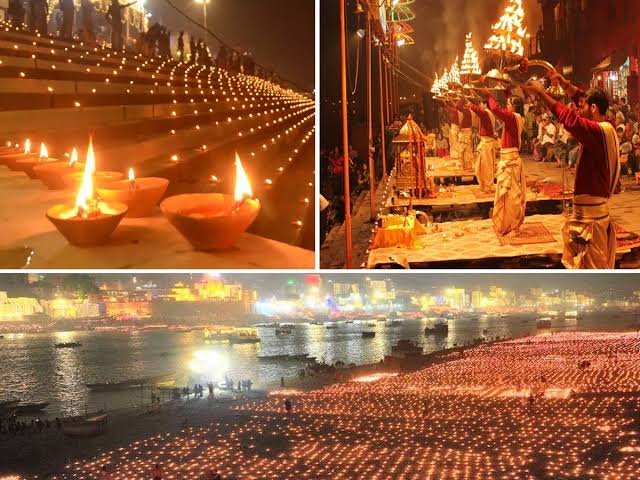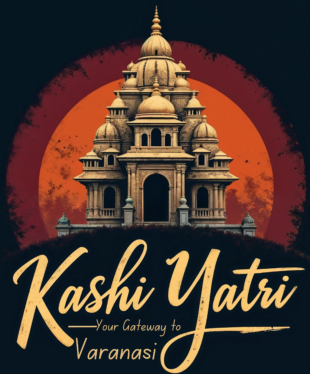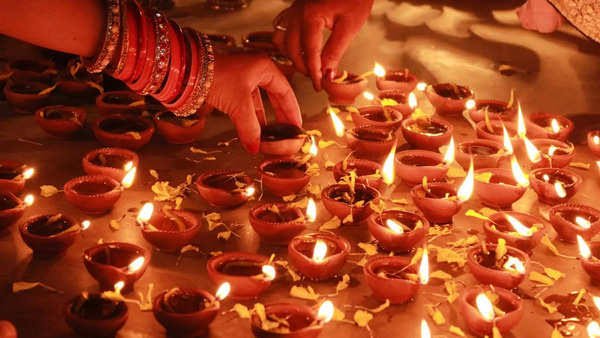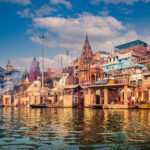Experience the breathtaking beauty of Dev Deepawali in Varanasi on November 15, 2024. Discover the essence of this spiritual celebration, including rituals, diya arrangements, and historical significance.
Dev Deepawali, often translated as “Diwali of the Gods,” is one of the most revered festivals in Hindu culture, celebrated primarily on the ghats of Varanasi. This festival falls on Kartik Purnima, the full moon of the Kartik month, which is considered the holiest month in the Hindu lunar calendar. This year, Dev Deepawali will be observed on Friday, November 15, 2024.

Hindus associate the festival with the deities descending to Earth and blessing the participating devotees. The whole city, particularly the ghats along the Ganges, becomes vibrant with a mesmerizing exhibition of numerous oil lamps, music, dance, and devotion, generating a mystical and captivating atmosphere.
Historical Significance of Dev Deepawali: The Story of Lord Shiva’s Victory
The origins of Dev Deepawali trace back to ancient Hindu mythology. According to legend, the festival celebrates the victory of Lord Shiva over the demon Tripurasura. As the story goes, Tripurasura had acquired immense powers through penance and used them to spread terror across the universe. His tyranny became intolerable for the gods and sages, who sought Lord Shiva’s intervention. To restore balance, Shiva took on his most formidable form and destroyed Tripurasura on Kartik Purnima, symbolizing the triumph of good over evil and the end of darkness with the arrival of divine light.
The destruction of Tripurasura is symbolic of destroying negative energies and ignorance. This victory is commemorated every year as Dev Deepawali. Hindus believe that the gods descend to Earth on this night to participate in the festivities, bestowing blessings upon those who light lamps and make offerings. Dev Deepawali is therefore a festival that celebrates both light and wisdom, cleansing devotees of past sins and bringing spiritual purity.
The Importance of Dev Deepawali in Varanasi
Varanasi, also known as Kashi, is a city of profound spiritual significance, believed to be blessed by Lord Shiva himself. The city is considered one of the oldest and holiest in the world, where life and death merge as pilgrims seek spiritual liberation. Dev Deepawali in Varanasi is an extraordinary celebration, with the city’s ghats becoming a sanctuary of lights, prayers, and devotion. Each year, over a million diyas illuminate the riverbanks of the Ganges, creating an ethereal experience that is unparalleled anywhere else in the world.

During Dev Deepawali, thousands of pilgrims and devotees gather to perform Deepdaan (the offering of lamps) and take part in the rituals of Kartik Purnima. The Ganges River, revered as the holiest river, is the focal point of the celebration. Taking a dip in the Ganges on this day is believed to wash away sins, making it a significant part of the Dev Deepawali celebrations.
Rituals and Customs of Dev Deepawali
Dev Deepawali is a festival rich in rituals, each with its own spiritual significance. Here are some of the key customs that are practiced on this sacred day:
1. Ganga Snan (Holy Bath) on Kartik Purnima
The ritual bath, or Ganga Snan, is an essential part of the Dev Deepawali festival. Pilgrims begin their day by taking a holy dip in the Ganges, as it is believed to cleanse them of their sins and purify their souls. Bathing in the Ganges during Kartik Purnima is especially auspicious, and people from various regions travel to Varanasi to immerse themselves in the spiritual significance of this ritual. The act of Ganga Snan symbolizes a renewal of faith, an opportunity for repentance, and a fresh beginning.
2. Puja and Deepdaan (Offering of Lamps)
After the holy bath, devotees perform aarti (prayer) and offer prayers to Lord Shiva, who is considered the presiding deity of Varanasi. The evening is the most sacred time for performing Deepdaan, during which diyas are lit in honor of the deities. This act is seen as an offering to the gods, inviting their blessings and protection. Thousands of diyas illuminate the ghats, creating a breathtaking view that symbolizes the removal of darkness from the lives of devotees. Deepdaan is often accompanied by chanting mantras and prayers, which enhance the spiritual aura of the festival.
Dev Deepawali Puja Niyam: Guidelines for Lighting Diyas on Dev Deepawali
One of the most essential aspects of Dev Deepawali is the lighting of diyas. However, there are specific Puja Niyams (rules) that devotees adhere to, ensuring that their offerings are pure and spiritually significant. Here are the guidelines for lighting diyas on Dev Deepawali:
1. Number of Diyas to Light
In Hindu tradition, odd numbers are considered auspicious, as they are believed to bring good luck. For Dev Deepawali, it is recommended to light 5, 7, 9, 11, 51, or 101 diyas. Some families choose to light hundreds or even thousands of diyas to honor the gods. The act of lighting diyas in an odd number is considered beneficial, symbolizing an endless cycle of prosperity.
2. Special Diyas for Lord Shiva
As Dev Deepawali is closely associated with Lord Shiva, offering multi-faced diyas (known as mukhi diyas) is considered highly auspicious. Devotees often light diyas with 8 or 12 faces to honor Lord Shiva, as these numbers are associated with his divine energy. The multi-faced diyas represent different forms of protection, wisdom, and blessings from the deity.
3. Type of Diyas to Use
Clay diyas are preferred for Dev Deepawali, as they represent purity and connection to Mother Earth. It is customary to soak the diyas in water before use to cleanse them. Clay diyas are seen as a humble and environmentally conscious way to connect with nature and pay homage to the divine.
4. Selection of Oil for Diyas
The type of oil used in the diyas holds specific significance in Hindu rituals:
- Ghee (Clarified Butter): Ghee diyas are considered the purest and are often used as an offering to deities. Lighting diyas with cow ghee is said to purify the atmosphere and attract positivity. Ghee is particularly recommended for diyas dedicated to Lord Shiva, as it amplifies spiritual vibrations.
- Mustard Oil: Mustard oil is also a preferred alternative, especially for households with limited access to ghee. The pungent aroma of mustard oil is thought to ward off negative energies.
- Til (Sesame) Oil: Another commonly used oil is sesame oil, which symbolizes purification and longevity.
Placement of Diyas on Dev Deepawali
The placement of diyas also holds symbolic value, influencing the energy flow in the home and surroundings:

- Ishan Kon (Northeast Corner): Diyas placed in the northeast corner of the home are believed to align the energy with the blessings of Lord Shiva, bringing spiritual growth and peace.
- East, North, and West Directions: Diyas placed in specific directions hold unique blessings:
- East: Increases health and longevity.
- North: Attracts prosperity and wealth.
- West: Removes obstacles and provides peace.
- Riverbanks and Temples: Many devotees make offerings along the banks of the Ganges and in temples, which is thought to enhance the blessings received.
- Home Shrines: For those unable to visit the ghats, lighting diyas in the home shrine is equally powerful, as it invites divine energy into the personal space.
Mantras and Chants for Dev Deepawali
Chanting mantras and prayers while lighting diyas is essential for invoking blessings on Dev Deepawali. These mantras elevate the mind and purify the environment, creating an atmosphere of devotion:
- Shubham Karoti Kalyaanam Aarogyam Dhan Sampadaa
Translation: “I bow to the lamp that brings prosperity, auspiciousness, health, and wealth and destroys negative energies.” - Deepo Jyoti Parabrahma Deepo Jyoti Janardana
Translation: “The light of the lamp is the Supreme Brahman, may this light take away my sins.” - Om Namah Shivaya: This universal mantra of Lord Shiva is often chanted throughout Dev Deepawali to invoke his blessings.
By reciting these mantras, devotees enhance the sacredness of the occasion, elevating their prayers and intentions.
The Grand Celebration of Ganga Aarti on Dev Deepawali
One of the most mesmerizing sights of Dev Deepawali is the Ganga Aarti held on the ghats. The aarti is a beautiful ritual involving a synchronized performance of priests who hold large brass lamps and chant in unison. The ritual is dedicated to Ganga Maa (Mother Ganges), as devotees express their gratitude and reverence for the river that sustains life and washes away sins. The aarti creates a powerful energy, with rhythmic chanting, incense, and swirling lamps enhancing the spiritual atmosphere.
For devotees, witnessing the Ganga Aarti on Dev Deepawali is a divine experience, as it creates a connection with the supreme and a sense of transcendence that is rarely found elsewhere.
Dev Deepawali’s Impact on Local Economy and Tourism
Dev Deepawali has also become a significant event for tourism in Varanasi, drawing visitors from across the world. The festival boosts the local economy as hotels, restaurants, and markets see a surge in business. Artisans who make diyas, decorative items, and traditional attire witness high demand during this period.

The celebration of Dev Deepawali not only preserves spiritual traditions but also sustains Varanasi’s unique cultural heritage.
Conclusion: The Divine Light of Dev Deepawali
Dev Deepawali is more than just a festival; it’s an experience of spiritual enlightenment, a celebration of light over darkness, and a reminder of the eternal divine presence. For millions of believers, Dev Deepawali represents a renewal of faith, a dedication to righteousness, and a time to seek blessings for the coming year. The magical glow of diyas on the ghats of Varanasi illuminates the hearts of all who witness it, leaving them with a sense of peace, fulfillment, and divine connection.
In 2024, as the lamps of Dev Deepawali light up Varanasi, let us remember the deeper meaning of this celebration — a journey toward wisdom, compassion, and the eternal light within.







